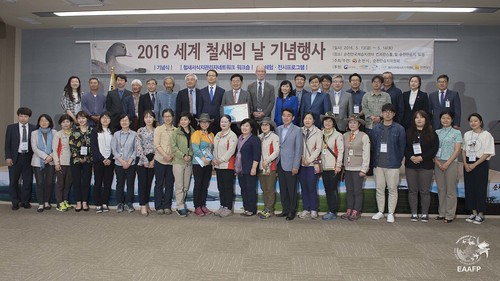Miyoung Choi, Finance Officer, EAAFP Secretariat
The World Migratory Bird Day 2016 national celebration and the Korean Site Managers Workshop were held at the Suncheon Bay Wetland Center in Suncheon, the Republic of Korea (RoK), 13-14 May 2016. Over 200 participants from central and local governments, national institutes, NGOs and international organizations including EAAFP and Ramsar Regional Center-East Asia participated in the event. Suncheon is known as a tourist site for its extensive bay area with rich biodiversity supporting a variety of costal plants and animals as well as the scenic view resulted from well protected natural environment. Suncheon Bay [EAAF079] is one of the most important migratory waterbird habitats, visited by millions of migratory birds every year. It is an EAAFP Flyway Network Site for its importance for Hooded Crane conservation.
At the celebration event, Chung-Hun Cho, Mayor of Suncheon introduced the history of how Suncheon became a sustainable city by taking actions to conserve the bay area and their natural resources like Hooded Cranes, and revealed its future plan and strategy for further improvement. Spike Millington, Chief Executive of EAAFP Secretariat explained that migratory waterbirds are threatened along the flyway, especially by habitat loss and that it is important to conserve migratory waterbirds and their habitats, especially coastal wetlands like Suncheon tidal flat for us and future generations. Minho Lee, General Director of the Ministry of Environment of Korea, remarked the importance of Korea as a stopover site along the East Asian-Australasian Flyway and the necessity of cooperation among all relevant parties, including central and local governments, institutes, NGOs and international organizations to conserve migratory waterbirds. Inan Elementary School made a beautiful performance with harmonious ocarina chorus. This local school was once planned to be closed but revived through their collaborative work for crane conservation programs of Suncheon Bay. Now this school with a total of 100 students is famous for its eco-friendly educational programs.
The site managers’ workshop brought participants from various sites together. There were many presentations on the results of studies and long-term conservation efforts by NGOs in the RoK. Experts and site managers shared their experience, information and best practices obtained through their conservation efforts. First, Suncheon City government showcased the best practices of conservation actions through the conservation of Suncheon Bay. Through their study, the economic value of the Suncheon Bay wetland is estimated at around $1 billion. This shows how nature compensates us when we take care of it and cooperate for its conservation. Then, Dr. Jinyeong Lee of the National Institute of Biological Resources introduced the status of migratory waterbirds and their migration in Korea, and Tomoko Ichikawa, Communication Officer of EAAFP Secretariat explained the importance of international cooperation for the conservation of migratory waterbirds and their habitats. Since cranes are important migratory species for the RoK, there were many presentations about the current conservation status of cranes from various regions, including Hooded Crane in Suncheon (Min Sinae, Suncheon City), The wintering status of cranes in Cheolwon (Dr. Rue Senghwa, National Institute of Ecology), Cranes in Seosan (Kim Shinghwan, Citizens’ Association in Seosan), and Cranes in East Asia and the role of the wetlands in Korea (Dr. Lee Kisup, director of Seoul Zoo). In addition, there were presentations on storks reintroduction (Dr. Eun, Jongmin), vulture conservation (Kim Deockseong, Society for the Protection of Birds), swallow monitoring (Oh Gwangseock, Upo Ecosystem Education Center), and shorebirds status in Korea (Kim Incheol, Wetlands International Korea).
Migratory birds can bring people with different backgrounds, regions, culture and language together because they are not limited by political boundaries and are a shared treasure of all countries. The participants agreed to work together in order to boost their efforts and achieve their common goal, the conservation of migratory waterbirds. EAAFP Secretariat set up a booth to promote migratory waterbird conservation providing educational activities. Interns and volunteers joined to raise awareness among citizens and visitors to the wetland center.
Agenda and programme: 2016 World Migratory Bird Day National Celebration and Korean Site Managers Workshop
Relevant articles (Korean):
http://news.heraldcorp.com/view.php?ud=20160515000213 http://www.yonhapnews.co.kr/bulletin/2016/05/13/0200000000AKR20160513143100054.HTML?input=1195m?b31e92c0
More photos:
https://www.flickr.com/photos/eaafp/albums/72157666628402614


